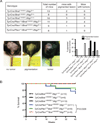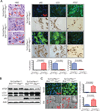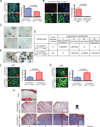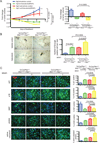Atg7 Overcomes Senescence and Promotes Growth of BrafV600E-Driven Melanoma
- PMID: 25673642
- PMCID: PMC4390491
- DOI: 10.1158/2159-8290.CD-14-1473
Atg7 Overcomes Senescence and Promotes Growth of BrafV600E-Driven Melanoma
Abstract
Macroautophagy (autophagy hereafter) may promote survival and growth of spontaneous tumors, including melanoma. We utilized a genetically engineered mouse model of melanoma driven by oncogenic BrafV600E and deficiency in the Pten tumor suppressor gene in melanocytes to test the functional consequences of loss of the essential autophagy gene autophagy-related-7, Atg7. Atg7 deficiency prevented melanoma development by BrafV600E and allelic Pten loss, indicating that autophagy is essential for melanomagenesis. Moreover, BrafV600E-mutant, Pten-null, Atg7-deficient melanomas displayed accumulation of autophagy substrates and growth defects, which extended animal survival. Atg7-deleted tumors showed increased oxidative stress and senescence, a known barrier to melanomagenesis. Treatment with the BRAF inhibitor dabrafenib decreased tumor growth and induced senescence that was more pronounced in tumors with Atg7 deficiency. Thus, Atg7 promotes melanoma by limiting oxidative stress and overcoming senescence, and autophagy inhibition may be of therapeutic value by augmenting the antitumor activity of BRAF inhibitors.
Significance: The essential autophagy gene Atg7 promotes development of BrafV600E-mutant, Pten-null melanomas by overcoming senescence, and deleting Atg7 facilitated senescence induction and antitumor activity of BRAF inhibition. This suggests that combinatorial BRAFV600E and autophagy inhibition may improve therapeutic outcomes in patients whose tumors have BRAFV600E/K mutations, an approach currently being explored in clinical trials.
©2015 American Association for Cancer Research.
Conflict of interest statement
Disclosure of potential conflict of interest: The authors have no potential conflicts of interest that pertain to this work.
Figures






Comment in
-
Targeting Autophagy in BRAF-Mutant Tumors.Cancer Discov. 2015 Apr;5(4):353-4. doi: 10.1158/2159-8290.CD-15-0222. Cancer Discov. 2015. PMID: 25847956 Free PMC article.
-
Loss of autophagy affects melanoma development in a manner dependent on PTEN status.Cell Death Differ. 2021 Apr;28(4):1437-1439. doi: 10.1038/s41418-021-00746-7. Epub 2021 Mar 4. Cell Death Differ. 2021. PMID: 33664481 Free PMC article. No abstract available.
References
-
- Siegel R, Ma J, Zou Z, Jemal A. Cancer statistics, 2014. CA: a cancer journal for clinicians. 2014;64:9–29. - PubMed
-
- Ott PA, Hodi FS, Robert C. CTLA-4 and PD-1/PD-L1 blockade: new immunotherapeutic modalities with durable clinical benefit in melanoma patients. Clin Cancer Res. 2013;19:5300–5309. - PubMed
-
- Davies H, Bignell GR, Cox C, Stephens P, Edkins S, Clegg S, et al. Mutations of the BRAF gene in human cancer. Nature. 2002;417:949–954. - PubMed
Publication types
MeSH terms
Substances
Grants and funding
LinkOut - more resources
Full Text Sources
Other Literature Sources
Medical
Molecular Biology Databases
Research Materials

